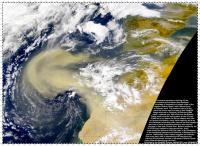AEROSOL GROUP
Mineral Dust
Mineral dust is a very interesting type of aerosol. Particles are generally much larger than other aerosol types, particularly close to the source. Particles can reach diameters of up to 100 microns. These larger particles are big enough to significantly absorb infra-red radiation, thus behaving as greenhouse gases, unlike other types of aerosols. Mineral dust also scatters and absorbs solar radiation. Dust from different areas (e.g. Sahara vs Chinese) can have significantly different chemical compositions and hence different optical properties. This makes simulating the cliamtic impact of dust particularly challenging, especially in the long wave part of the spectrum.
Since mineral dust is naturally produced in the semi-arid areas of the globe, it is very hard to assess the additional anthropogenic component due to land use changes such as deforestation and over-grazing. A further complication is that other normally water soluble aerosol species such as sulphates can become combined with the dust, substantially changing the optical properties of the sulphate aerosol and allowing new chemical reactions to take place.
 Figure courtesy of SeaWifs Project, NASA Goddard and OrbiImage |
Dust can have a large local impact on the radiation, particularly during intense dust storms. Dust from the Sahara is frequently transported across the Atlantic ocean to East Coast USA. |
FENNEC (Sahara)
This project is a consortium involving Oxford, Leeds, Sussex and Imperial College as well as Reading and the Met Office. We aim to provide new measurements of dust, meteorology and boundary layer dynamics across the deep Sahara during 2011, probing the mechanisms responsible for the Saharan heat low and dust uplift.
Dust Outflow and Deposition to the Ocean (DODO) Campaign
This project involved 2 aircraft campaigns in Africa. We have recently published the results from the aircraft measurements of aerosol properties. We are also developing a new dust scheme within weather and climate forecasting versions of the UM. Please see the DODO pages for more information.
SHADE campaign results
A recent observational campaign of the Met. Research Flight, SHADE, took measurements of particles and radiation fluxes during some of these type of events in September 2000. We (Ellie Highwood and Mike Silverstone) worked on the detection of the impact of Saharan dust on long wave radiation. Using high spectral resolution measurements of radiation in the atmospheric window region we were able to detect a distinctive signal of dust, and to recommend a suitable refractive index for use in radiative transfer modelling. We also demonstrated the potentially large impact of dust on some satellite retrievals of sea surface temperature. This work has recently appeared in a special section of JGR dedicated to the SHADE campaign. Click here for pdf version of Highwood et al. (2003).. Other publications from the campaign in which the group were involved are Tanre et al. (2003). and Haywood et al. (2003).